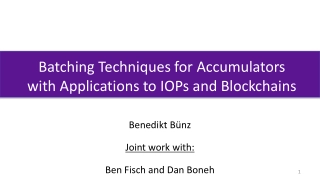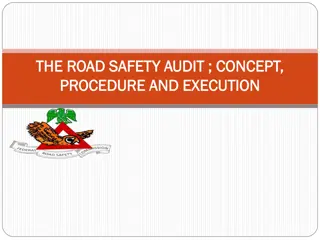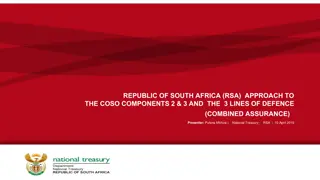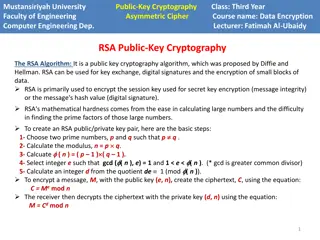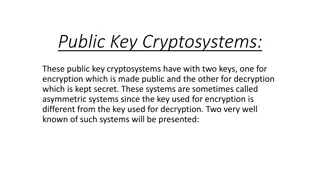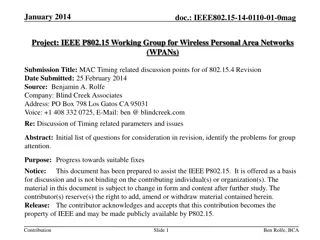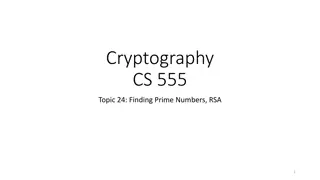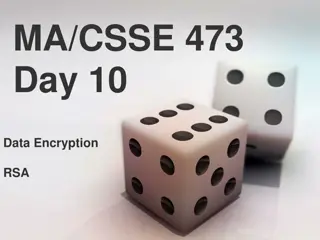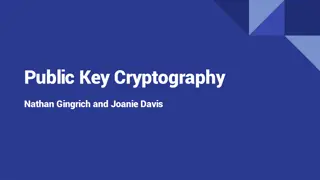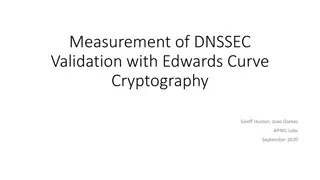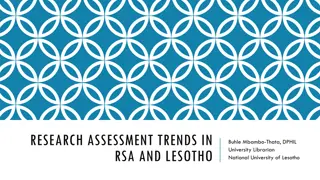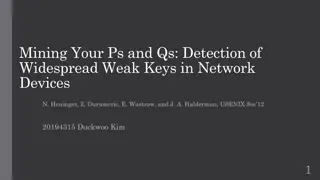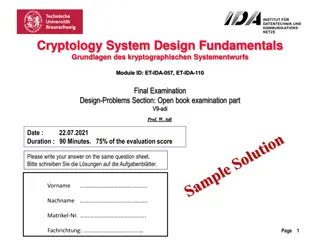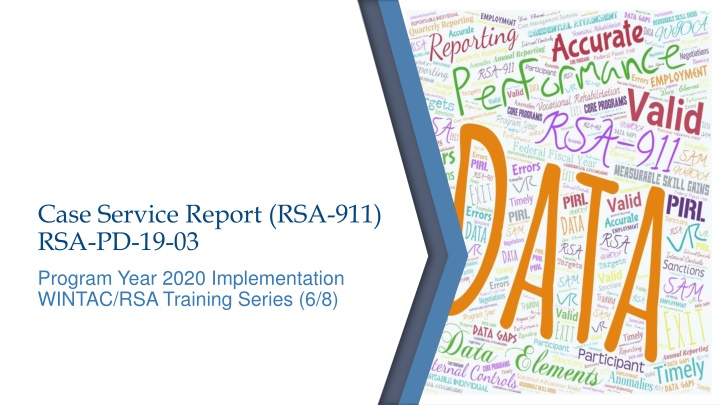
RSA-911 Reporting Changes for Vocational Rehabilitation Agencies
Explore the significant updates in RSA-911 reporting requirements for Vocational Rehabilitation agencies, including changes from PD 16-04 to PD 19-03, required exit and post-exit data elements, quarterly reporting obligations, and tools/resources available for compliance.
Download Presentation

Please find below an Image/Link to download the presentation.
The content on the website is provided AS IS for your information and personal use only. It may not be sold, licensed, or shared on other websites without obtaining consent from the author. If you encounter any issues during the download, it is possible that the publisher has removed the file from their server.
You are allowed to download the files provided on this website for personal or commercial use, subject to the condition that they are used lawfully. All files are the property of their respective owners.
The content on the website is provided AS IS for your information and personal use only. It may not be sold, licensed, or shared on other websites without obtaining consent from the author.
E N D
Presentation Transcript
Case Service Report (RSA-911) RSA-PD-19-03 Program Year 2020 Implementation WINTAC/RSA Training Series (6/8)
Training Series Objectives 1. Explain the intent of PD-19-03 reporting requirements. 2. Assist State Vocational Rehabilitation (VR) agencies in the implementation of the Case Service Report (RSA-911). 3. When possible, share examples of what needs to live outside of RSA-911 reporting, in addition to the discussed data elements (e.g., source documentation). 4. Provide considerations and expectations during each training (e.g., policies State VR agencies need to establish and implement, available tools and resources, and internal controls). 2
Presenters Andy Kerns, RSA Rachel Anderson, WINTAC 3
Exit & Post-Exit Reporting (6/8 Training Series) January 2020
Todays Training 1. The Why behind RSA-911 Changes Changes from PD 16-04 to PD 19-03 2. Required Exit Data Elements 3. Required Post-Exit Data Elements 4. Quarterly Reporting Requirements 5. Tools/resources 5
Exit & Post-Exit Reporting The Why Behind RSA-911 Changes
Changes PD 16-04 to PD 19-03 RSA modified the list of choices or reporting instructions for the following exit Data Elements (DE): DE 354: Type of Exit DE 355: Reason for Program Exit DE 356: Employment Outcome at Exit DE 357: Primary Occupation at Exit DE 359: Hourly Wage at Exit DE 360: Hours Worked in a Week at Exit DE required at exit: DE 358: Start Date of Employment in Primary Occupation DE 361-375: Benefits at Exit 7
Changes PD 16-04 to PD 19-03 (continued) DE required Post-Exit: DE 380-382, 384, 387-388, 390-391: Employment Quarters After Exit Example DE 381: Type of Employment Match - 1st Quarter After Exit Example DE 390: Wages 4th Quarter After Exit RSA added two DE required at Exit: DE 396: Monthly Public Support at Exit DE 397: Medical Insurance Coverage at Exit RSA modified the Reasons for Exit (Appendix 6): DE 355: Reason for Program Exit 8
Date of Exit Data Element 353 In DE 353, the VR agency reports the date the individual exited from the VR program consistent with the requirements in the regulations. Leave blank if this data element does not apply to the individual (i.e., they have not exited the VR program). The date must be verifiable through supporting documentation. 10
Type of Exit Data Element 354 In DE 354, the VR agency reports from which stage in the VR process an individual exited the program. 1. = Individual exited during or after a trial work experience 2. = Individual exited after eligibility, but from an order of selection waiting list 3. = Individual exited after eligibility, but prior to a signed IPE4 4. = Individual exited after a signed IPE without an employment outcome 5. = Individual exited after a signed IPE in noncompetitive and/or nonintegrated employment 6. = Individual exited after a signed IPE in competitive and integrated employment or supported employment 7. = Individual exited as an applicant after being determined ineligible for VR services 0. = Individual exited as an applicant, prior to eligibility determination or trial work RSA deleted Code Value 8 Exited as Potentially Eligible Student with a Disability as an option for DE 354 (View RSA-911 Training #3: Pre-Employment Transition Services.) 11
Reason for Exit Data Element 355 In DE 355, the VR agency reports the reason the individual exited. Data are reported in the same quarter as the Date of Exit (DE 353) occurs. Dependent upon the Reason for Exit, participants are either included or excluded from the WIOA Performance Indicators. Exclusions include the following: No longer available for services due to incarceration or residence in an institutional setting No longer available for service due to a health or medical issue Have become deceased Called to active duty Determined ineligible 12
DE 355 Code Values & WIOA Performance Inclusions Code Values Exclusions Code Values 13 Transferred to Another Agency 02 Health/Medical 14 Achieved Competitive Integrated Employment Outcome 03 Death of Individual 04 Reserve Forces Called to Active Duty 16 Extended Services Not Available 17 Unable to Locate 06, 08, 21, 22 Ineligible 18 No Longer Interested in Receiving Services or Further Services 07 Criminal Offender 15 Extended Employment 20 Short-Term Basis Period 19 All Other Reasons 13
Ineligibility Four Reasons for Exit Options Code 06: The individual was determined eligible for the VR program; however, the individual was no longer eligible because he or she no longer wished to seek competitive integrated employment or the individual s disability prevented the individual s ability to seek competitive integrated employment. Code 08: The individual was found to have no disabling condition, no impediment to employment, or did not require VR services to prepare for, secure, retain, advance in, or regain competitive integrated employment. Code 21: The individual applied for VR services pursuant to section 511 of the Rehabilitation Act and was determined ineligible because he or she did not wish to pursue competitive integrated employment. Code 22: Following Trial Work Experience(s), the individual was determined ineligible because the individual was unable to benefit due to the severity of his or her disability. 14
PD 19-03 Appendix 6 Crosswalk RSA-911 PD 16-04 RSA-911 PD19-03 Code Reason for Exit Code Reason for Exit Individual is No Longer Available for Services Due to Residence in an Institutional Setting Other Than a Prison or Jail 1 19 All Other Reasons: This code is used for all other reasons not included in other code values. Health/Medical: Individual is hospitalized or receiving medical treatment that is expected to last longer than 90 days and precludes entry into competitive integrated employment or continued participation in the program. 2 Health/Medical 2 3 Death of Individual 3 Death of the Individual Reserve Forces Called to Active Duty: Individual is a member of the National Guard or other reserve military unit of the armed forces and is called to active duty for at least 90 days. 4 Reserve Forces Called to Active Duty 4 5 Foster Care 19 All Other Reasons: This code is used for all other reasons not included in other code values. Ineligible: The individual was determined eligible for the VR program; however, the individual was no longer eligible because he or she no longer wished to seek competitive integrated employment or the individual s disability prevented the individual s ability to seek competitive integrated employment. 6 Ineligible after determine eligible 6 Criminal Offender: Individual entered a correctional institution (e.g., prison, jail, reformatory, work farm, detention center) or other institution designed for confinement or rehabilitation of criminal offenders (section 225 of WIOA). 7 Criminal Offender 7 Ineligible: The individual was found to have no disabling condition, no impediment to employment, or did not require VR services to prepare for, secure, retain, advance in, or regain competitive integrated employment. 8 No Disabling Condition 8 Ineligible: The individual was found to have no disabling condition, no impediment to employment, or did not require VR services to prepare for, secure, retain, advance in, or regain competitive integrated employment. 9 No Impediment to Employment 8 Ineligible: The individual was found to have no disabling condition, no impediment to employment, or did not require VR services to prepare for, secure, retain, advance in, or regain competitive integrated employment. 10 Does Not Require VR Service 8 Ineligible: The individual was determined eligible for the VR program; however, the individual was no longer eligible because he or she no longer wished to seek competitive integrated employment or the individual s disability prevented the individual s ability to seek competitive integrated employment. 11 Disability Too Significant to Benefit from Service 6 15
PD 19-03 Appendix 6 Crosswalk (continued) RSA-911 PD 16-04 RSA-911 PD19-03 Code Reason for Exit Code Reason for Exit Extended Services Not Available: Individual has received VR services but requires long term extended services for which no long term source of funding is available. This code is used only for individuals who have received VR services. 12 No Long Term Source of Extended Services Available 16 Transferred to Another Agency: Individual needs services that are more appropriately obtained elsewhere. Transfer to another agency indicates that appropriate referral information is forwarded to the other agency so that agency may provide services more effectively. Include individuals transferred to other VR agencies. 13 Transferred to Another Agency 13 Achieved Competitive Integrated Employment Outcome: Applicable only to Type of Exit code value 6 (Individual exited after an IPE in competitive and integrated employment, or supported employment). 14 Achieved Competitive Integrated Employment Outcome 14 Extended Employment: Individuals who received services and were placed in a non-integrated or sheltered setting for a public or private nonprofit agency or organization that provides compensation in accordance with the Fair Labor Standards Act (34 CFR 361.5(c)(18)). 15 Extended Employment 15 Extended Services Not Available: Individual has received VR services but requires long term extended services for which no long term source of funding is available. This code is used only for individuals who have received VR services. 16 Extended Services Not Available 16 Unable to Locate or Contact: Individual has relocated or left the State without a forwarding address, or when individual has not responded to repeated attempts to contact the individual by mail, telephone, text, or email. 17 Unable to Locate or Contact 17 No Longer Interested in Receiving Services or Further Services: Individual actively chose not to participate or continue in the VR program. Also use this code to indicate when an individual s actions make it impossible to begin or continue a VR program. Examples would include repeated failures to keep appointments for assessment, counseling, or other services. No Longer Interested in Receiving Services or Further Services 18 18 19 All Other Reasons 19 All Other Reasons: This code is used for all other reasons not included in other code values. Short-Term Basis Period: The individual achieved supported employment in integrated employment, but did not earn a competitive wage after exhausting the short term basis period. 20 Ineligible: The individual applied for VR services pursuant to section 511 of the Rehabilitation Act and was determined ineligible because he or she did not wish to pursue competitive integrated employment. 21 Ineligible: Following Trial Work Experience(s), the individual was determined ineligible because the individual was unable to benefit due to the severity of his or her disability. 22 16
Example #1 Reason for Exit A VR participant is trying to attend training, while also working and getting other aspects of his life on track. The individual has been missing school and not showing up for work. In addition, he routinely misses appointments with his VR Counselor because he says he is too busy. This has been consistent for an extended period of time, regardless of multiple attempts by the VR Counselor to engage him in his IPE. DE 354: Type of Exit Code 4 Individual exited after an IPE without an employment outcome. DE 355: Reason for Exit Code Value 18 No Longer Interested in Receiving Services or Further Services: Individual actively chose not to participate or continue in the VR program. Also use this code to indicate when an individual s actions make it impossible to begin or continue a VR program. Examples would include repeated failures to keep appointments for assessment, counseling, or other services. 17
Example #2a Reason for Exit A youth with a disability applies for VR services, but before she is determined eligible, she decides that she is not interested in pursuing CIE and wants to continue working in subminimum wage employment. The counselor finds the person ineligible. DE 354 Type of exit: Code 0 Individual exited as an applicant, prior to eligibility determination or trial work. DE 355 Reason for exit: Code 21 Ineligible: The individual applied for VR services pursuant to Section 511 of the Rehabilitation Act and was determined ineligible because he or she did not wish to pursue competitive integrated employment. Section 511 Example 18
Example #2b Reason for Exit A youth with a disability applies for VR services and is found eligible. He develops an IPE with his VR Counselor, and the VR agency provides services. However, he later determines that he is no longer interested in pursuing CIE and, as a result, the VR Counselor determines that he is ineligible. DE 354 Type of exit: Code 4: Individual exited after an IPE without an employment outcome. DE 355 Reason for exit: Code 6: Ineligible: The individual was determined eligible for the VR program; however, the individual was no longer eligible because he or she no longer wished to seek competitive integrated employment or the individual s disability prevented the individual s ability to seek competitive integrated employment. Section 511 Example 19
Example #3 Reason for Exit A VR participant begins working; however, she is struggling to work due to the effects of her disability. Because of significant health concerns, she decides to focus on her recovery and stop working. As a result, she has indicated that she is no longer interested in pursuing CIE. DE 354: Type of Exit Code 4 Individual exited after an IPE without an employment outcome. DE 355: Reason for Exit Code Value 06 Ineligible: The individual was determined eligible for the VR program; however, the individual was no longer eligible because he or she no longer wished to seek competitive integrated employment or the individual s disability prevented the individual s ability to seek competitive integrated employment. 20
Employment Outcome at Exit DE 356 Element Number Element Name Data Type Multiple Values Allowed Change (from PD1604) Report at Report Updateable after initial reporting (Y/N) Definitions or Instructions Code Values 356 INT 1 No Modified list of choices Exit Data Elements Upon Occurrence No Report the code that identifies the type of employment outcome at exit. Data are reported in the same quarter as the Date of Exit (353) occurs. 1 = Competitive Integrated Employment 2 = Self-Employment 3 = Randolph- Sheppard BEP 4 = State Agency Managed BEP 5 = Supported Employment in Competitive Integrated Employment 7 = Homemaker Employment Outcome at Exit 21
Employment Data at Exit DE 357-360 Element Number Element Name Data Type Multiple Values Allowed Change (from PD1604) Report at Report Updateable after initial reporting (Y/N) Definitions or Instructions Code Values 357 INT 6 No Modified reporting instructions Exit Data Elements Upon Occurrence No For an individual who is employed, enter the current 2018 Standard Occupational Classification (SOC) code that best describes the individual s occupation from which he/she derives the majority of his/her hourly earnings. XXXXXX Primary Occupation at Exit ***Special Codes for Randolph-Sheppard Participants:899999 Randolph-Sheppard Vending Facility Clerk, 999999 Randolph Sheppard Vending Facility Operator. Use this special code even though these occupations are classifiable 359 DEC 5,2 No Modified reporting instructions Exit Data Elements Upon Occurrence No XX.XX Hourly Wage at Exit Report individual s hourly wage (rounded to the nearest cent) earned at the time of exit. Report 0 if individual had no earnings at the time of exit The data must be verifiable through supporting documentation. 360 INT 2 No Modified reporting instructions Exit Data Elements Upon Occurrence No Report the number of hours the individual worked for earnings in a typical week at the time of exit. XX Hours Worked in a Week at Exit Report 0 if individual was unemployed. 22
Post-Exit Data Elements Section 116 of WIOA Performance Accountability
Credential Attainment Post-Exit Discussed in depth in RSA-911 Training #5 on Credential Attainment and Measurable Skill Gains 24
Special Rule Secondary Credential Attainment As required in WIOA section 116(b)(2)(A)(iii), participants who obtain a secondary school diploma or its recognized equivalent must also meet an additional condition before they are counted as a successful outcome and included in the numerator of the credential attainment indicator. These participants must be employed, or enrolled in an education or training program leading to a recognized postsecondary credential within one year following exit. DE 376: Date Enrolled in Post-Exit Education or Training Program Leading to a Recognized Postsecondary Credential DE 379: Employment - First Quarter After Exit Quarter DE 383: Employment - Second Quarter After Exit Quarter DE 386: Employment - Third Quarter After Exit Quarter DE 389: Employment - Fourth Quarter After Exit Quarter 25
Post-Exit Credential Attainment Credential Attainment is the percentage of those participants enrolled in an education or training program who attained a recognized postsecondary credential or a secondary school diploma, or its recognized equivalent, during participation in or within one year after exit from the program. Data Element 377: Date of Attainment of Post-Exit Recognized Credential Data Element 378: Type of Recognized Credential Attained Post-Exit (Note* See examples in Training #5) 26
Employment Rate 2nd Quarter After Exit (DE 383) Element Number Element Name Data Type Change (from PD1604) PIRL Element Report at Report Updateable after initial reporting (Y/N) Definitions or Instructions Code Values 383 Employment -Second Quarter After Exit INT1 Modified reporting instructions 1602 Post-Exit Data Elements Quarterly Yes Employment must be verifiable through supporting documentation 1 = Individual is in unsubsidized employment, not including Registered Apprenticeship, the military, or competitive integrated employment under VR 2 = Individual is in a Registered Apprenticeship 3 = Individual is in the military 4 = Individual is in competitive integrated employment (VR only) 9 = Individual has exited but employment information is not yet available 0 = Individual not employed in the first quarter after exit quarter 28
Employment Rate 2nd Quarter After Exit Percentage of participants in unsubsidized employment during the second quarter after exit from the program Data Element 383: Employment-Second Quarter After Exit Quarter Denominator = Count of Participants reported in the Program Year who exited in the previous Program year with Exit Reason (DE355) code = 13, 14, 16, 17, 18, or 19 Numerator = Count of Participants in the denominator with Employment Second Quarter After Exit Quarter (DE383) code = 1, 2, 3, or 4 29
Employment Rate 2nd Quarter After Exit (DE 385) Element Number Element Name Data Type Change (from PD1604) PIRL Element Report at Report Updateable after initial reporting (Y/N) Definitions or Instructions Code Values 385 Quarterly Wages - Second Quarter After Exit Quarter DEC 8, 2 Yes 1704 Post-Exit Data Elements Upon Occurrence Yes Record the total wages, including cents, earned, from the employment outcome consistent with the employment goal on an individual s IPE at the time the individual exited, during the second quarter after the quarter of exit. These earnings are before payroll deductions of Federal, State and local income taxes and Social Security payroll tax. XXXXX.XX Wages must be verifiable through supporting documentation. 30
Median Earnings 2nd Quarter After Exit Median earnings of those in unsubsidized employment during the second quarter after exit from the program Data Element 385: Quarterly Wages-Second Quarter After Exit Quarter Value in which there is an equal number of higher and lower values from the Quarterly Wages-Second Quarter After Exit Quarter (DE385) for Participants reported in Program Year who exited in the previous Program Year where DE385 value is greater than 0 and less than $999,999.00. 31
Employment Rate 4th Quarter After Exit (DE 389) Element Number Element Name Data Type Change (from PD1604) PIRL Element Report at Report Updateable after initial reporting (Y/N) Definitions or Instructions Code Values 389 Employment -Fourth Quarter After Exit INT1 Modified reporting instructions 1606 Post-Exit Data Elements Quarterly Yes Employment must be verifiable through supporting documentation 1 = Individual is in unsubsidized employment, not including Registered Apprenticeship, the military, or competitive integrated employment under VR 2 = Individual is in a Registered Apprenticeship 3 = Individual is in the military 4 = Individual is in competitive integrated employment (VR only) 9 = Individual has exited but employment information is not yet available 0 = Individual not employed in the first quarter after exit quarter 32
Employment Rate 4th Quarter After Exit Percentage of participants in unsubsidized employment during the fourth quarter after exit from the program Data Element 389: Employment-Fourth Quarter After Exit Quarter Denominator = Count of Participants reported in the Program Year who exited in the first or second quarter of the previous Program year or the third or fourth quarter of the Program Year prior to that with Exit Reason (DE355) code = 13, 14, 16, 17, 18, or 19 Numerator = Count of Participants in the denominator with Employment Fourth Quarter After Exit Quarter (DE389) code = 1, 2, 3, or 4 33
Retention with the Same Employer (DE 392) Element Number Element Name Data Type Change (from PD1604) PIRL Element Report at Report Updateable after initial reporting (Y/N) Definitions or Instructions Code Values 392 Retention with the Same Employer in the Second Quarter and the Fourth Quarter Fourth Quarter After Exit Quarter INT 1 No 1618 Post-Exit Data Elements Upon Occurrence No 1 = Individual s employer in the second quarter after exit matches the employer in the fourth quarter after exit. 0 = Individual is not employed in the second or fourth quarters after exit, or the employer in the second quarter after exit does not match the employer in the fourth quarter after exit. 34
Retention with the Same Employer Effectiveness in Serving Employers Retention with the same employer in the 2nd Quarter and the 4th Quarter After Exit Data Element 392: Retention with the Same Employer in the Second Quarter and the Fourth Quarter Fourth Quarter After Exit Quarter 35
Example Reporting Requirements Post-Exit If a participant exits the VR program on September 15, 2018, the participant exited during PY 2018 Q1, which ends on September 30, 2018. The SVRA must collect and report information on this participant for six full quarters, through the end of PY 2019 Q3. Due to the two quarter lag in receiving UI wage record data, the SVRA receives the PY 2018 Q3 data, which reflects the participant s employment in the 2nd Quarter after Exit and Median Earnings in the 2nd Quarter after Exit, in PY 2019 Q1; the SVRA then reports this data in the quarterly report due to RSA by November 15, 2019. Similarly, the SVRA receives the PY 2019 Q1 data, which reflects the participant s employment in the 4th Quarter after Exit, in PY 2019 Q3; the SVRA then reports this data in the quarterly report due to RSA by May 15, 2020. 37
Example Reporting Requirements Post-Exit (continued) PY Quarter Exit Quarter Quarter End Date Quarterly Report Due to RSA Data Q1 0 September 30, 2018 November 15, 2018 Participant exits during PY 2018 Q1 2018 Q2 Q3 1 2 December 31, 2018 March 31, 2019 February 15, 2019 May 15, 2019 - Employment 2nd Quarter after Exit; and Median Earnings 2nd Quarter after Exit 2018 2018 Q4 3 June 30, 2019 August 15, 2019 Employers report wage data from PY 2018 Q3 to State UI Employment 4th Quarter after Exit 2018 Q1 4 September 30, 2019 November 15, 2019 2019 State UI provides SVRA with the PY 2018 Q3 data SVRA reports the PY 2018 Q3 data to RSA by November 15, 2019 Q2 5 December 31, 2019 February 15, 2020 Employers report wage data from PY 2019 Q1 to State UI State UI provides SVRA with the PY 2019 Q1 data 2019 Q3 6 March 31, 2020 May 15, 2020 2019 SVRA reports the PY 2019 Q1 data to RSA by May 15, 2020 SVRA reporting on this participant concludes 38
Internal Controls Internal controls should ensure accurate tracking and reporting of all exit and post-exit data. Internal controls should prevent agencies from reporting exit and post-exit data without data validation procedures, including the use of allowable source documentation. Internal controls should identify possible anomalies or outliers in the data being reported. For example, if the VR agency reports that an individual is working at exit or post-exit, internal controls should ensure that wages are also reported on the RSA-911. 39
RSA-911 Training Series 1. Background and Implementation 2. Reporting Expenditures for VR Services 3. Pre-Employment Transition Services (Pre-ETS) 4. Supported Employment (SE) Services 5. Measurable Skill Gains (MSG) and Credential Attainment 6. Exit and Post-Exit Data Elements 7. New Data Elements Additional Need to Know Information 8. RSA-911 Information Used in the WIOA Annual Report 40
Resources: Exit & Post-Exit RSA-PD-16-04 Case Service Report (RSA-911) https://www2.ed.gov/policy/speced/guid/rsa/subregulatory/pd-16-04.pdf RSA-PD-19-03 Case Service Report (RSA-911) https://www2.ed.gov/policy/speced/guid/rsa/subregulatory/pd-19-03.pdf RSA -TAC-17-01 https://www2.ed.gov/policy/speced/guid/rsa/subregulatory/tac-17- 01.pdf?utm_content=&utm_medium=email&utm_name=&utm_source=govdelivery&ut m_term= RSA-911 Crosswalk (August 14, 2019) https://www2.ed.gov/rschstat/eval/rehab/case-service-report-rsa-911-crosswalk-of- changes.xlsx WINTAC FAQs (includes reporting requirements post-exit example) http://www.wintac.org/topic-areas/transition-common-performance-accountability- system/faqs 41
Contact Andy Kerns Information Technology Specialist (202) 245-6265 RSAData@ed.gov rsa.ed.gov Rachel Anderson (435) 764-8487 randerson@ndi-inc.org www.WINTAC.org 42


